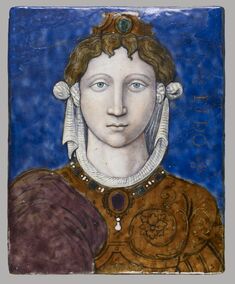Aeneas, Prince of Troy
(Renaissance Europe )
The Trojan prince Aeneas fled his burning city (around 1300 BCE) in what is now Turkey and, with companions, set out to find a new land to start again, as famously told by the Roman poet Virgil in the "Aeneid" (29–20 BCE). After years of wandering, they came to Italy, where he founded the city of Rome. He is pictured wearing a plumed helmet, a breast-plate enriched with a lion's mask, and a mantle fastened on his left shoulder by an intaglio brooch. This depiction references his brief landing at Carthage (in North Africa) and his infatuation with Queen Dido. See the companion plaque of Dido, Queen of Carthage, (Walters 44.240) for a discussion of the story and sources.
The plaques are from a series based on Ovid's pairs of lovers by the enamel painter to teh French court.
Provenance
Provenance (from the French provenir, 'to come from/forth') is the chronology of the ownership, custody, or location of a historical object. Learn more about provenance at the Walters.
Castle of Gaillon (?). George Robinson Harding, London; William T. or Henry Walters Collection, Baltimore; by bequest to Walters Art Museum, 1931.
Exhibitions
| 1995 | Carthage: l'histoire, sa trace et son écho. Musée du Petit Palais, Genève. |
Conservation
| Date | Description | Narrative |
|---|---|---|
| 11/28/1956 | Treatment | other |
| 7/23/1965 | Treatment | other |
| 11/20/1987 | Treatment | cleaned; loss compensation; examined for condition |
| 9/29/1994 | Loan Consideration | examined for loan |
| 2/15/1995 | Treatment | cleaned; loss compensation |
Geographies
France, Limoges (Place of Origin)
Measurements
H without frame: 11 1/2 x W: 9 5/16 in. (29.2 x 23.6 cm)
Credit Line
Acquired by William T. or Henry Walters
Location in Museum
Accession Number
In libraries, galleries, museums, and archives, an accession number is a unique identifier assigned to each object in the collection.
In libraries, galleries, museums, and archives, an accession number is a unique identifier assigned to each object in the collection.
44.239





